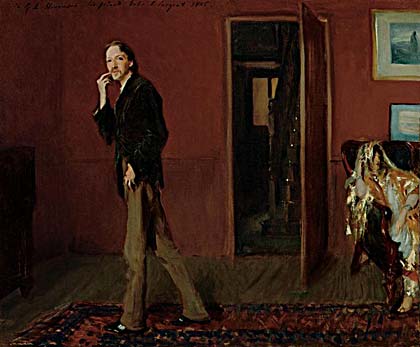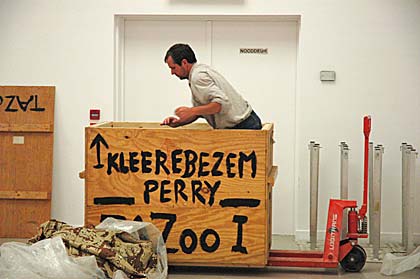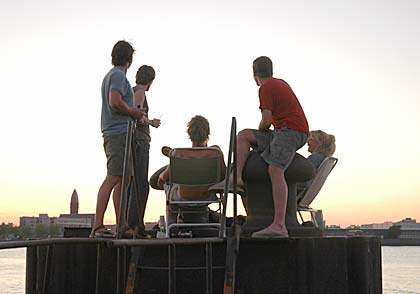
|
Present
Past
Subjects
Projects
Misc

|
JUNE 2005
WEDNESDAY, 1 JUNE 2005
We were in Berlin for a few weeks last month, N. performing her piece while I was just generally hanging out reading and watching films in our apartment Prenzlauerberg (Thank you Stefan for introducing me to the extraordinary films of Claire Denis!).
I'm looking forward to listening to Peter Sloterdijk this evening! More later...
THURSDAY, 2 JUNE 2005
Title of Sloterdijk's talk yesterday evening: 'If Nothing Happens'.
SUNDAY, 5 JUNE 2005
Recap
Tuesday, 26 April:
"And then what happened?" Narratology -- story telling -- requires causality and linear time. Acausal (or synchronistic) 'situations' contain no narrative. Narrative appears in the question.
The Story and the Thing Itself
|
"I'm sorry I reached this point because I'm about to talk about my own work in a certain way and it's going to sound like these stories are connected, but I promise you they're not connected in any way, it's just a coincidence."
"I have the idea that there's something about visual art - that is, the intellectual part of visual art - that is away from language, and that its value is that it's away from language. It's a knowledge that is not connected to language. When I have some great experience with a work of art, something that I love, something like Monet's paintings or some really good stuff, the importance of it, what's moving to me, what changes me is the part that's knowledge away from language, that can't be explained in language, and it makes me feel suddenly free. Because, I think because, at least partly, I am suddenly free of this prison of words, the prison of language."
"I try to make art that's not connected to metaphor, that hasn't this descriptive, metaphorical, architectural weight to it. But I think my tendency, and most artists' tendency - most artists that I know, especially, in the last 20 years - is to make instructive art, art that instructs us about something, or to make sublime art - art that says, "I'm the sensitive person, I'm your guide and you could never have seen this without me, the sensitive artist showing it to you". I think those are the two sins we now have in art, I feel that for myself."
Jimmie Durham speaking about Facts and Fiction
|
MONDAY, 6 JUNE 2005
From the Fables of Robert Louis Stevenson: The Song of the Morrow.
In order to prepare for a seminar on "re-enactment" this coming fall I've started to collect stories, films and other forms of art which address the notion of 'The Eternal Recurrence of the Same'. All suggestions welcome.

John Singer Sargent: Robert Louis Stevenson and his Wife (1885)
Note: it seems that Stevenson was a "pacer" when he wrote.
TUESDAY, 7 JUNE 2005
A Critique of Modern Popular Art
The modern Wagnerian artist, according to the late Nietzsche (and the lively Sloterdijk) seduces the audience by evoking (through craft and clever arrangement) "overwhelming feelings" which the artist, herself, does not feel.
To do this the modern Wagnerian artist enters into a psychopathological relationship with her spectators -- first diagnosing and then fulfilling the innermost wants and desires of her audience. An audience who, "convinced only that no conviction is possible" comes to the artist seeking temporary emotional revitalisation.
According to Sloterdijk (high) art begins where this psychopathological, dominant-submissive, sadomasochistic relation ends.
See selected excerpts from Nietzsche's 'The Case of Wagner' (courtesy of The Nietzsche Channel).
WEDNESDAY, 8 JUNE 2005
To Jump
Jumps are blind.
Sloterdijk describes contemporary man as he or she who cannot act of his own accord, who can only jump and allow the natural forces of 'freefall' to determine their subsequent actions. Jumping is seen as the only possibility to motivate ourselves to action, to become "disinhibited" in our present age (Kierkegaard: "One can say in general of a passionless but reflective age, compared to a passionate one, that it gains in extensity what it loses in intensity.") This is the modern condition.
Two possibilities for jumping: We jump (and feel alive) when threatened with a life-threatening situation (Blanchot: "The disaster takes care of everything.") OR we jump more or less of our own accord, through our own reasoning, as 'Sovereigns', as an act of will.
In other words voluntary jumping is when we 'willfully' accept a condition of stress, when we commit a crime (oh what audacity it takes to produce art), when we take a risk and chance being caught with our pants down, when we commit by accepting a deadline which puts something of our self at stake (also known as the "call" artist).
THURSDAY, 9 JUNE 2005
More on The Jump
|
Kierkegaard's 'Springet'
"Action and decision is as scarce in the present age as peril is absent from shallow-water paddling. But just as the adult being tossed about delightfully by the waves calls to the younger person: "Come on, just jump into the deep water" - the decision likeways, so to speak, lies within existence (but in the individual, naturally), and shouts to the younger person not yet exhausted by an excess of reflection...: "Come on, jump boldly in." Even if it is a reckless leap, so long as it is decisive - if you have it in you to be a man, then the danger and life's stern judgement upon your recklessness will help you become one."
Søren Kierkegaard, Excerpts from "The Present Age" (Nutiden) (scroll down for quote).
|
|
The Abrupt
"The abrupt is real, if 'abrupt' is understood, not as one of the many possible synonyms for 'harsh' and 'uneven,' but as denoting a mode of being characterized by discontinuity. Here the abrupt is, therefore, a kind of "leap." To a certain extent, it may be understood by analogy with the Kierkegaardian notion of Springet (leap, jump), which describes the movement of human existence as opposed to the dialectical process of Being in the Hegelian sense. Like the Kierkegaardian notion, the Unamunian intuition of "leap" is fiercely opposed to either continuity or to mediation. It is as remote from Hegelianism as it is from Leibnizianism. The real does not stretch out on a continuous line; it does not follow the pattern of evolution, either continuous or dialectical. There is no "sufficient reason" for its existence, nor is there any explanation of the course it follows. Instead of "reason" and "explanation" we have here--again, in a Kierkegaardian sense--"decision." This decision presupposes the acceptance of absurdity and paradox. And yet, the obvious analogies between the Kierkegaardian and the Unamunian notions of "leap" must not lead us to the conclusion that their meanings are interchangeable. Kierkegaard thought that the "leap" describes the behavior of human existence in the passage from one stage of life to another, and especially in the passage from the ethical stage to the religious. The Kierkegaardian notion of leap is thus comparable to one of those categories that Heidegger has called "existentials." On the other hand, Unamuno did not explicitly think of the leap as a category, whether existential or cosmic, but confined himself to describing the universe, and above all human beings, as if they were geological faults: layer upon layer without any apparent transition. Furthermore, whereas the leaps leading from one stage to another were conceived by Kierkegaard in such a way that every stage was supposed to be replaced by the ensuing one, we never find in Unamuno the idea, or even the intuition, that once a stage is attained all the preceding ones must be forgotten or dismissed."
Ferrater Mora, 'On Miguel De Unamuno's Idea Of Reality'.
|
Under consideration: abruptions in the Bardos, the 'jump cut' in film, confused timelines, non-linear narratives, philosophical defenestration.

Jumps are blind.
MONDAY, 13 JUNE 2005
The Potlatch King
|
"As Bataille understands it, gift giving does not mark a limit between civilization and barbarity. Rather, it is the demise of the potlatch, the loss of the practice of loss, that signifies the transition from a society dominated by an aristocracy to an industrial society dominated by the bourgeoisie. Bataille defines the bourgeoisie as the class that gives away nothing: (...) governed by "a reasoning that balances accounts," the bourgeoisie maintains a "sterility in regard to expenditure." It holds itself in an intimate proximity to itself by keeping its wealth close at hand. Hence it is openly hostile towards the possibility of loss: "bourgeoisie socity has only managed to develop a universal meaness," says Bataille, for "the bourgeois are incapable of concealing a sordid face, a face so rapacious and lacking in nobility, so frighteningly small, that all human life, upon seeing it, seems degraded.""
Christopher Bracken: The Potlatch Papers, 1997
|
My Current Short List of Potlatch Kings:
The KLF (The K Foundation) for buring 1 million UK pounds (of their own money) on the 23 of August 1994. Ryoei Saito, the late chairman of Daishowa Paper Manufacturing, who in the mid 90's scandalised the world of art by threatening to have two of his recent auction purchases, Van Gogh's 'Portrait of Dr. Gachet' and Renoir's 'Renoir's 'At the Moulin de la Galette', bought for a total of 160.6 million dollars (82.5 million and 78.1 million respectively), cremated with his body when he died. Alexander, who in the last scene of Tarkovsky's last film 'The Sacrifice' burns down his house and contents (a house which in reality had to be built and burned twice).
More suggestions?
FRIDAY, 17 JUNE 2005
Giraffe Building 2005
Jouke and I reunited today in Antwerpen to install 'Moveable Observation Post - High View Point' a collaborative work from 1993 for this summer's Ensemble show at the MuHKA. It's been 9 years since we last saw the piece (at the Magasin in Grenoble) and not surprisingly it took quite a few hours to figure out how it all -- aluminum frames, bones, skull, skins, leather belts, Desert Storm camouflage, cameras and LCD panels -- went together again.

JK searches for missing pieces.

Giraffe building 2005.
Opening: Saturday 25 June at 11:00 A.M.
Museum of Contemporary Art
Leuvenstraat 32, 2000 Antwerp
SATURDAY, 18 JUNE 2005
I'm still thinking about JK's use of the phrase 'educated guess' to describe the dynamics of a jury's (artistic) selection. It sure fits the situation better than 'complex lottery', an expression I found myself using recently.
SUNDAY, 19 JUNE 2005
Rotterdam Life

18.06.05 Down by the river (Heijplaat).
FRIDAY, 24 JUNE 2005
Memory and Barbarism
|
"The ethical expression for what Abraham did is that he was willing to murder Isaac; the religious expression is that he was willing to sacrifice Isaac; but in this contradiction lies the very anguish that can indeed make one sleepless; and yet without that anguish Abraham is not the one he is. Or perhaps Abraham simply didn't do what the story says, perhaps in the context of his times what he did was something quite different. Then let's forget him, for why bother remembering a past that cannot be made into a present?"
Søren Kierkegaard, Fear and Trembling
|
SUNDAY, 26 JUNE 2005
To Create Difficulties Everywhere
Question: What did Kierkegaard want? (Title of the New Criterion essay by Roger Kimball)
Kierkegaard: "I conceived it as my task to create difficulties everywhere."
TUESDAY, 28 JUNE 2005
Executioner's Song
K's 'Fear and Trembling' unleashes a whirlwind of connections: the overwhelming art history of Judith and Holophernes and Salomé and John, orthodox religious icons of beheaded martyrs holding their own heads, the teleological suspension of the ethical in respect to both sacrifice and religious terrorism (historical: kamikaze, assassins, thugs, zealots / contemporary: suicide bombers), Bataille's Tears of Eros.
April 2005
ALAMUT.COM is artist owned and operated.
Mail: current address.

|

|





